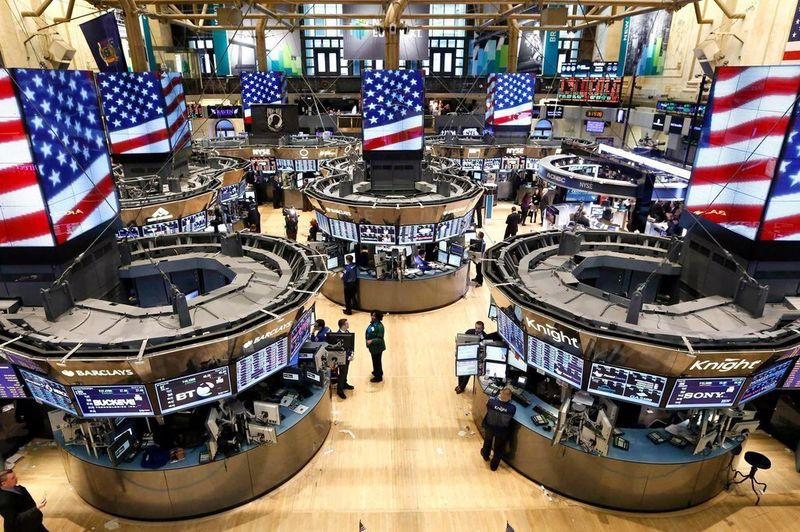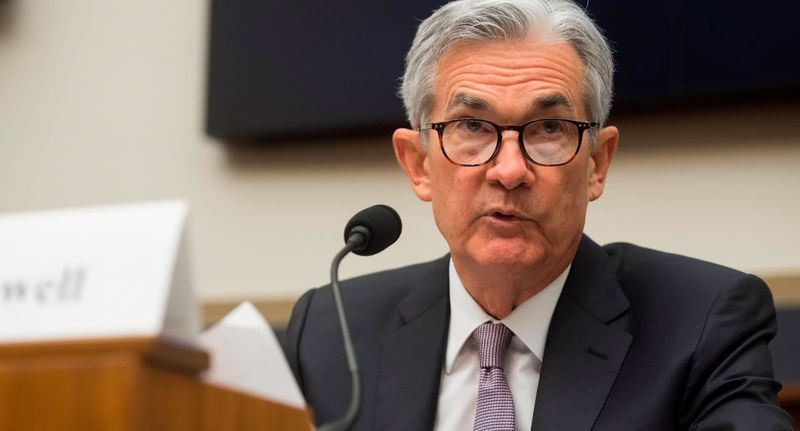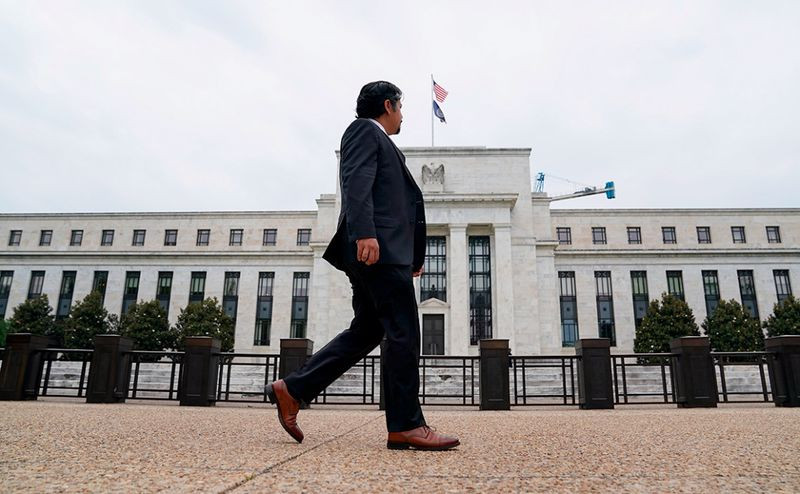
Markets held their breath waiting for the announcement of the Federal Reserve's verdict on monetary policy.
The main currency pairs were locked in narrow trading ranges.
On Tuesday, the greenback reached a high of more than two weeks around 96.25, after which it entered the consolidation phase.
The day before, the EUR/USD pair fell to a monthly low near 1.1265 before recovering to 1.1300.
This behavior of currencies is very different from the dynamics of the US stock market, which experienced a sell-off during the Asian session on Tuesday and resumed falling after the opening of New York sites.
Following the results of yesterday's trading, the Dow Jones index sank by 0.19%, the S&P 500 declined by 1.22%, and the Nasdaq lost 2.28%.
At the same time, the VIX (the so-called "Wall Street fear index") rose by 4.21% to 31.16, reaching a new six-month high.
The high volatility of the stock market indicates the nervousness of investors who do not know how hawkish the statements of the US central bank will be following the results of the next meeting.
The central bank's position on a number of issues will determine the dynamics of the currency and stock markets in the near future.
Most analysts believe that for now the Fed should leave monetary policy unchanged. Nevertheless, the intrigue persists.
Market participants are eagerly awaiting further clues about the timing and pace of interest rate hikes, as well as when and how the central bank is going to cut almost $9 trillion on its balance sheet, a process dubbed quantitative tightening (QT).
If the high-tech Nasdaq is already mastering the correction zone, then the S&P 500 broad market index is about to join it - it has less than 1% left before entering the "bearish" territory. At the moment, the index has retreated from the record high recorded in early January by more than 9%.
On Wednesday, futures on the main Wall Street indices are recovering in the hope of the softness of the comments of Fed Chairman Jerome Powell, who will take into account the fall in stocks, according to investors who are now buying.

The recent sell-off in the stock market was caused by concerns that the US central bank will begin to tighten policy earlier and faster than expected.
According to CME, traders estimate the probability of an increase in the federal funds rate at the March FOMC meeting at almost 95%, and the probability of four rises for the entire 2022 exceeds 85%. Moreover, the chances of a fifth increase have increased to almost 60%.
Goldman Sachs analysts believe that the acceleration of inflation in the United States may lead to the Fed becoming even more aggressive than expected regarding rate hikes this year.
"We see the risk that the Fed will want to take certain steps to tighten monetary policy at the end of each meeting until the inflation picture changes," they said.
JPMorgan Chase also sees a pretty good chance of more than four rate hikes, considering even six or seven rate hikes possible.
The turbulence of the US stock market since the beginning of the month should send a clear signal to the Fed that it is not ready for such tough steps by the central bank. In the fall of 2018, Powell missed such a signal by insisting on further rate hikes in 2019.
Did the Fed chairman draw any conclusions from that episode? This is a question for hundreds of billions of dollars, which can be added or disappear from the capitalization of companies traded on the US stock market.
If the central bank is ready to raise the rate in March, then the "forward guidance" should indicate this.
At least, FOMC members confirmed this possibility in separate speeches.
At the same time, the central bank's increase in the key rate by 25 basis points has already been fully taken into account in the quotes. According to forecasts, the rate will increase by 100 basis points in total over the year.
Attempts to restore US stock indices and the consolidation of the dollar confirm these expectations, which means that in order to further strengthen the US currency, the Fed should show a very hawkish attitude.

If Powell will say that the rate hike will begin in March, and it will take more than four rounds of monetary policy tightening to contain inflation, the greenback will sharply strengthen against its main competitors. However, any scenario in addition to this can provoke a rally in stocks and other risky assets, reducing the demand for a protective USD.
For example, the head of the Fed may assume that inflation will normalize after several rounds of rate hikes or emphasize the dependence of the pace of policy tightening on economic indicators.
The key point will also be the announced role of the asset balance in normalizing the Fed's policy. If the central bank gives QT more weight, the forecast of four rate hikes this year may be under threat, respectively, a rollback of expectations will follow, which will deprive the US currency of support.
At the same time, the beginning of the reduction of the Fed's balance sheet at the meeting on March 16 is unlikely, since it is still growing and will finish growing closer to mid-March.
"What they will need to do is say that we will respond as the conditions require. We need to cope with inflation, and even with what we are seeing, financial conditions are too loose. This is the only message they can give now," Grant Thornton analysts believe.
"The fact that Fed officials are talking about reducing the balance sheet at the same time that they are still increasing it is a bit inconsistent. For this reason, we expect that there may be some disagreements at the current meeting, and at least one FOMC member, such as St. Louis Fed President James Bullard, may insist on an immediate cessation of purchases," they added.
If there is a need to accelerate the transition to normalization of monetary policy, the central bank could announce the end of quantitative easing at the January meeting, but FOMC members are unlikely to take this step, given the recent fall in stock indices.
If the Fed does announce the end of the active phase of QE at the current meeting, the shock is guaranteed, the stock market will collapse, and the greenback will soar amid investors' flight from risk.
A similar effect can be produced by the statement of Powell on the possibility of raising the rate immediately by 0.50% in March.
Although futures on major US stock indexes are rising by more than 1% on Wednesday, market sentiment remains fragile, strategists at TD Securities say.
"Any hints from the Fed on a starting point for QT or an "earlier" and "faster" rate hike may affect the market, but we do not expect final signals yet, and the result may be ambiguous," they said.
While waiting for the Fed's verdict on monetary policy, investors remain in a nervous state, which keeps the US currency afloat.
At the same time, traders are not in a hurry to buy the dollar, assessing how active the Fed's actions will be in the fight against inflation.

"We believe that the US central bank will say that it is going to use all the tools to combat inflation, which is still a problem, even though the S&P 500 index has fallen by 10%. We don't think they will be scared by this. They need to tighten financial conditions so that they can better cope with inflation. Therefore, the Fed is unlikely to come out and say that the market is misjudging four rate hikes this year," Bank of America strategists noted.
"We believe that the hawkish tone at the FOMC meeting can serve as a key catalyst for the next dollar growth. Our forecast for EUR/USD for this year remains at 1.1000, and it is likely that this level will be reached earlier. We expect the first increase in the federal funds rate in March, and then an increase of 25 basis points will be in each quarter. We predict that quantitative tightening will be announced at the meeting in June, but there is a risk that it will be done in May," they added.
On Wednesday, the USD index is moving sideways around 96.00, which allows the EUR/USD pair, which is trading today at 1.1300, to consolidate losses.
If the Fed reports that it may begin to reduce the balance sheet after the first rate hike, which will most likely take place in March, this will support the dollar. Moreover, the greenback is likely to benefit from the Fed's decision to complete quantitative easing earlier than planned by increasing the pace of curtailing monthly asset purchases.
On the other hand, the Fed may express concern about the deteriorating prospects for the global economy and take a cautious stance on tightening policy in the future. Such a tone of the central bank's statements may provoke a sharp recovery in US stocks and make it difficult for the dollar to find demand.
"Some market participants assume that today Powell may soften his tone a bit, and the FOMC will try to signal three, not four, rate hikes this year. Such an outcome may put pressure on the USD and provoke a breakthrough of the EUR/USD pair in the upward direction. In general, the current long positioning of the market in the US currency continues to indicate the potential of EUR/USD pullbacks. Taking into account the continuing divergence of the Fed and ECB rates, as well as the potential support for the USD from the flight of investors to safe havens, we prefer to sell the pair on growth, expecting further strengthening of the dollar by the middle of the year," Rabobank analysts said.
The technical picture, which has changed little since the previous day, indicates that attempts to restore the main currency pair are likely to remain short-lived.
In particular, EUR/USD remains below the bearish trend line from mid-January, and the RSI indicator remains below 50.
The nearest support is located at 1.1270, followed by 1.1250 and 1.1230.
The initial resistance was marked at 1.1300, and then at 1.1330 and 1.1350.
 English
English 
 Русский
Русский Bahasa Indonesia
Bahasa Indonesia Bahasa Malay
Bahasa Malay ไทย
ไทย Español
Español Deutsch
Deutsch Български
Български Français
Français Tiếng Việt
Tiếng Việt 中文
中文 বাংলা
বাংলা हिन्दी
हिन्दी Čeština
Čeština Українська
Українська Română
Română

